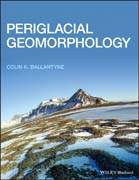
INDICE: Preface xi .Acknowledgement xiii .1 Introduction 1 .1.1 The Periglacial Concept: Definitions and Scope 1 .1.2 The Periglacial Realm 5 .1.3 The Development of Periglacial Geomorphology 5 .1.4 Periglacial Geomorphology: The Quaternary Context 7 .2 Periglacial Environments 11 .2.1 Introduction 11 .2.2 Periglacial Climates 11 .2.3 Soils in Periglacial Environments 17 .2.4 Vegetation Cover in Periglacial Environments 18 .2.5 Synthesis 20 .3 Ground Freezing and Thawing 23 .3.1 Introduction 23 .3.2 Ground Heating and Cooling 23 .3.3 Soil Freezing 28 .3.4 Ice Segregation in Freezing Soils 32 .3.5 Thaw Consolidation 37 .3.6 Synthesis 38 .4 Permafrost 39 .4.1 Introduction 39 .4.2 Permafrost Thermal Regime 40 .4.3 Classification of Permafrost 43 .4.4 Detection, Mapping and Modelling of Permafrost 44 .4.5 Permafrost Distribution 46 .4.6 Permafrost–glacier Interactions 53 .4.7 The Geomorphic Importance of Permafrost 54 .5 Ground Ice and Cryostratigraphy 57 .5.1 Introduction 57 .5.2 Genetic Classification of Ground Ice 57 .5.3 Description of Ground Ice 62 .5.4 Ice Contacts 66 .5.5 Cryostratigraphy 67 .5.6 The Transition Zone 69 .5.7 Massive Ground Ice 72 .5.8 Yedoma 76 .6 Thermal Contraction Cracking: Ice Wedges and Related Landforms 81 .6.1 Introduction 81 .6.2 Thermal Contraction Cracking and Polygon Evolution 81 .6.3 Ice Veins and Ice Wedges 84 .6.4 Ice]wedge Polygons 87 .6.5 Sand Veins and Sand Wedges 89 .6.6 Composite Veins and Composite Wedges 90 .6.7 Sand]wedge Polygons 90 .6.8 Frost Cracking of Seasonally Frozen Ground 91 .6.9 Thaw Modification of Frost Wedges 91 .6.10 Frost]Wedge Pseudomorphs and Frost Polygons in Areas of Past Permafrost 92 .7 Pingos, Palsas and other Frost Mounds 97 .7.1 Introduction 97 .7.2 Characteristics of Pingos 97 .7.3 Hydrostatic Pingos 99 .7.4 Hydraulic Pingos 101 .7.5 Pingo Problems and Problem Pingos 104 .7.6 Segregation Ice Mounds: Palsas, Lithalsas and Related Landforms 105 .7.7 Palsas 106 .7.8 Peat Plateaus 109 .7.9 Lithalsas 109 .7.10 Permafrost Plateaus 111 .7.11 Other Permafrost Mounds 111 .7.12 Ephemeral Frost Mounds 112 .7.13 Relict Permafrost Mounds 113 .8 Thermokarst 117 .8.1 Introduction 117 .8.2 Thermokarst Lakes and Drained Lake Basins 118 .8.3 Thermokarst Pits, Bogs and Fens 131 .8.4 Retrogressive Thaw Slumps 132 .8.5 Small]scale Thermokarst Features: Beaded Streams, Sinkholes and Thermokarst Gullies 136 .8.6 Sediment Structures associated with Thermokarst 138 .8.7 Relict Thermokarst Phenomena 139 .9 Seasonally Frozen Ground Phenomena 143 .9.1 Introduction 143 .9.2 Upfreezing of Clasts 143 .9.3 Frost Heave of Bedrock 145 .9.4 Patterned Ground: The Embroidery on the Landscape 145 .9.5 Patterned Ground Processes 147 .9.6 Sorted Patterned Ground 148 .9.7 Nonsorted Patterned Ground 155 .9.8 Cryoturbations 161 .9.9 Pedogenic Effects of Freezing and Thawing 164 .9.10 Fragipans 166 .9.11 Synthesis 167 .10 Rock Weathering and Associated Landforms 169 .10.1 Introduction 169 .10.2 Physical Weathering Processes 169 .10.3 Chemical Weathering Processes 177 .10.4 Biotic Weathering Processes 180 .10.5 Weathering Processes in Periglacial Environments 180 .10.6 Cold]climate Karst 181 .10.7 Tors 182 .10.8 Blockfields and Related Periglacial Regolith Covers 185 .10.9 Brecciated Bedrocks 192 .11 Periglacial Mass Movement and Hillslope Evolution 195 .11.1 Introduction 195 .11.2 Solifluction Processes 195 .11.3 Solifluction Landforms 204 .11.4 Pleistocene Solifluction Landforms and Slope Deposits 210 .11.5 Active]layer Failures 213 .11.6 Permafrost Creep 215 .11.7 Nivation 217 .11.8 Cryoplanation 220 .11.9 Slope Form and Slope Evolution 222 .12 Talus Slopes and Related Landforms 225 .12.1 Introduction 225 .12.2 Rockfall Talus 225 .12.3 The Geomorphic Role of Snow Avalanches 234 .12.4 Debris]flow Activity 237 .12.5 Rock Glaciers 240 .12.6 Pronival (Protalus) Ramparts 248 .12.7 Synthesis 250 .13 Fluvial Processes and Landforms 253 .13.1 Introduction 253 .13.2 Periglacial Hydrology 253 .13.3 Slopewash 259 .13.4 Slushflows 261 .13.5 Sediment Transport in Periglacial Rivers 261 .13.6 Bank and Channel Erosion 263 .13.7 River Channels 266 .13.8 Alluvial Landforms in Periglacial Environments 268 .13.9 Valley Form 270 .13.10 Pleistocene Periglacial Rivers 271 .13.11 Synthesis 273 .14 Wind Action 275 .14.1 Introduction 275 .14.2 Aeolian Processes 275 .14.3 Wind Erosion in Present Periglacial Environments 276 .14.4 Aeolian Deposits in Present Periglacial Environments 279 .14.5 Quaternary Aeolian Deposits 288 .14.6 Synthesis 297 .15 Periglacial Coasts 299 .15.1 Introduction 299 .15.2 The Nature of Periglacial Coasts 299 .15.3 The Role of Ice in Shoreline Evolution 301 .15.4 Ice]rich Permafrost Coasts 303 .15.5 Thermokarst Coasts 305 .15.6 Barrier Coasts 306 .15.7 Salt Marshes and Tidal Flats 308 .15.8 Rock Coasts 308 .15.9 Raised and Inherited Shorelines 309 .15.10 Lake Shorelines 310 .15.11 Synthesis 311 .16 Past Periglacial Environments 313 .16.1 Introduction 313 .16.2 Palaeoenvironmental Reconstruction Based on Periglacial Features 314 .16.3 Past Periglacial Environments of the British Isles 322 .16.4 Pre]Late Devensian Periglacial Features in the British Isles 323 .16.5 The Dimlington Stade in the British Isles 325 .16.6 The Younger Dryas (Loch Lomond) Stade in the British Isles 329 .16.7 Past Periglacial Environments of the British Isles: Commentary 332 .16.8 Late Weichselian Periglacial Environments in Continental Europe 332 .16.9 Late Wisconsinan Periglacial Environments in North America 341 .16.10 Permafrost Extent in the Northern Hemisphere During the Last Glacial Stage 344 .16.11 Concluding Comments 346 .17 Climate Change and Periglacial Environments 349 .17.1 Introduction 349 .17.2 Permafrost Degradation 352 .17.3 Geomorphological Implications of Climate Change in the Circumpolar North 356 .17.4 Geomorphological Implications of Climate Change in High Mountain Environments 363 .17.5 Climate Change, Permafrost Degradation and Greenhouse Gas Emissions 369 .17.6 Conclusion 371 .Appendix: Text Abbreviations, Units and Symbols Employed in Equations 373 .References 375 .Index 441
- ISBN: 978-1-4051-0006-9
- Editorial: Wiley–Blackwell
- Encuadernacion: Rústica
- Páginas: 472
- Fecha Publicación: 29/12/2017
- Nº Volúmenes: 1
- Idioma: Inglés
